
Subway excavations are changing the city's history

The Piazza Municipio excavations are in the heart of both the ancient and modern city. (Pasquale Sorrentino)
Chaos reigns in Naples, Italy's noisiest, craziest, and most frenetic city. Traffic lights are mere formalities. One-way streets are a joke and speed limits nonexistent. People park cars facing the wrong way, in the middle of the street, and if all else fails or the mood strikes, on the sidewalk. Being a pedestrian is a life-threatening adventure. Being a passenger in a car is not much better, and many would say worse. No city ever screamed more loudly for an improved subway system. Lack of funding, ever-changing governments with different priorities, and a peculiar Neapolitan need for a crisis to arise before anything gets done, have kept the city's harried inhabitants waiting. But the wait is over and, as part of a $22 billion regional transportation package, the expanded Naples Metropolitana subway is set to open in 2011. In the meantime, Italian archaeologists are having a field day.
As in many other European cities, such as Athens, which also has a new metro system after more than 30 years of construction, and Rome, whose metro is currently being expanded, subway construction has been a boon for archaeology in Naples. The city dates back more than 2,700 years, and thanks to the massive holes and tunnels needed for stations and tracks, according to Maria Luisa Nava, the city's archaeological superintendent, "It is no exaggeration to say that these excavations have changed the history of the city and altered our understanding of the place of Naples in the Mediterranean world." For the first time, archaeologists are able to identify when its important harbor was built, how it expanded when the need arose, and contracted when the city's character changed from commercial port to luxury retreat. Previously unknown aspects of the Greco-Roman, Byzantine, Angevin, and later topography have been uncovered. And the discovery of an extraordinary temple complex has bolstered the importance of the little-known Isolympic Games, a Hellenic-style contest instituted by the glory-hungry Roman emperor Augustus.

Conservators restore a 16th-century pavement 24 feet below modern street level. (Pasquale Sorrentino)
The epicenter of the work is the Piazza Municipio, the site of the main metro station for the new Metropolitana linea 1 that runs through the heart of the city. Dominated by the great Castel Nuovo, and with a view of the always teeming coastline, the crowded piazza is an unlikely place for archaeological excavation. Whether it's the cars whizzing by, the noise of construction equipment and hundreds of workers, the constant sirens, the airplanes landing at Capodichino just miles away—or maybe it's just Naples—the inescapable din makes it hard to hear Daniela Giampaola, chief archaeologist of the Metro Excavations Project. "We did not try to find treasures, but to reconstruct the glory of Naples' history. And we have succeeded," she says about the last four years of remarkable work here. And amidst the huge cranes, backhoes, bulldozers, and workers, we can catch sight of the dozens of archaeologists working to make this happen.
Starting at the modern street level and walking down into the excavation areas, we follow Giampaola through Naples' extraordinary story, all of which—from the Roman period to the nineteenth century—is represented by exceptional finds in the piazza. As we stand at the foot of the massive castle, we see an impressive ramp that connected the city's sixteenth-century walls, previously obscured by the modern piazza, with the castle. Below and on our right, Giampaola points out some yellow, red, and blue pigments on the wall, traces of colored frescoes from the Angevin period that perhaps decorated a small chapel. It becomes quieter as we descend until, at about 24 feet below the street, there is a little oasis away from the noise, stark contrast to the frantic pace and massive scale of the modern-day life above. Here eight conservators and students work to consolidate the fragile sixteenth-century terracotta pavement of a space for the storage of cannonballs and horse stalls that may overlay a second- to third-century Roman mosaic. They repair each crack with tiny sponges and mini trowels, using a paste made of sand and water. "The area is so big and there is so much work to do that we have decided to divide the excavation into sectors," explains project archaeologist Vittoria Carsana as we return to the noisy street level. "In one area, we are excavating the fifteenth century and the Roman period, in another, the Angevin. Recently, we also found remains of a fifth-century A.D. building that belongs to a late Roman villa in the area where the thirteenth-century Castel Nuovo now stands."
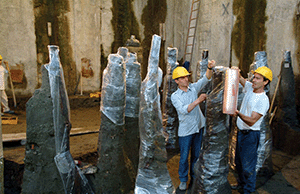
Workers protect the stakes that once supported one of the piers of the ancient Roman port. (Pasquale Sorrentino)
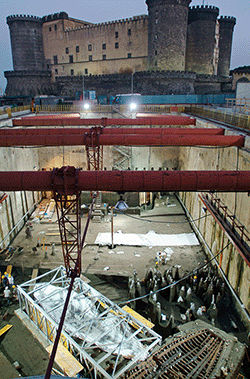
Preparing two of the discovered ships for removal during excavations of the Roman port. (Pasquale Sorrentino)
Returning to the piazza, we look down into an enormous hole dug for the Metropolitana's tracks a short distance from the castle. Here archaeologists have located the port of Roman Neapolis (Naples' ancient name), some 600 feet back from the modern coast. Since the nineteenth century, scholars such as Neapolitan historian Bartolomeo Capasso, have posited that this was the location of the ancient port, but until now there was no archaeological evidence. Pointing out a noticeable change in the color of the soil from a medium brown to a much lighter, sandier color, Giampaola explains that we are looking at a layer corresponding to the fifth century A.D. At this time, the harbor began to fill with sand and mud sliding down from the hill behind it, a recurring phenomenon in Naples' history poetically called "lava of the virgins." It was this silting up, though, that protected the harbor area's most thrilling discovery—the hulls of three first-century A.D. Roman ships. For five months the team excavated around the ships, finding personal items likely belonging to the ships' sailors, including dice, rope, mats, needles for sewing nets, baskets, carpenters' tools, and even several pairs of leather shoes. They were able to identify two of the ships as oneraria, or commercial vessels for medium-range trips, such as to the port of Rome at Ostia. The third ship is a rare horeia, a kind of in-harbor shuttle similar to examples from Toulon (ancient Telo Maius) in France.
In September 2004, it was time to move the ships to safety as subway work needed to continue. Giannegidio Silva, project engineer and chairman of the Society of the Metropolitana of Naples, admits that the long process of excavation and removal was a bit frustrating at times. "We are trying to save everything," he said, looking into the hole that now reaches 90 feet down, to the level of the tracks and stations and well under the level of the port. "But we also have to make this work in a modern city. This is the interesting part of the project for me, trying to make these two things work together. A great excavation inside a great public work." After removing the ships in a tricky operation that involved slipping huge sheets of fabric underneath and lifting them out of the thick mud, archaeologists continued excavating. In the thick layers of mud under the Roman port, they located traces of the very first harbor dredging, dating to sometime close to 326 B.C. At this time Neapolis became a kind of naval partner with Rome, and had to greatly expand the port to receive large ships bringing goods from all over the world. Artifacts have also revealed the changing nature of the port in the second century B.C., when Puteoli, some seven miles away, became the main commercial port. Earlier cargoes of utilitarian objects, such as ceramic lamps and transport amphorae from North Africa and Spain, were eventually replaced by luxury goods, including Megarian goblets from Greece, a valuable terracotta vase from Delos, and gray bucchero pottery from Ampurias in Spain—items serving the elite population that now spent summers in villas on what is still one of the world's most beautiful coastlines.
As for the ships themselves, they are now stored in a climate-controlled building in the quiet suburb of Piscinola, in ship-shaped fiberglass tubs filled with cold water changed every 15 days. Entering the building, the 46-degree-Fahrenheit temperature is shocking after the roasting summer day. Everyone speaks in hushed tones as if noise would damage the fragile ships. Ciro Sessa, the guard in charge of the ships, remarks, "It is a grand experience to be in charge of something like this. The spirit of the Romans is really here." And it is. Under the cover of green plastic mesh, the ships sit in water that helps preserve the wood previously protected by mud and silt for more than 2,000 years. But it is easy to imagine the sailors steering the ships along the sunny Italian coastline and delivering their contents to the bustling city. It is one of those moments when, for an instant, the past is very, very close.
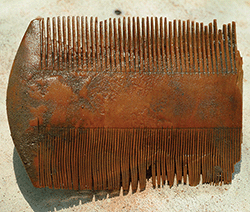
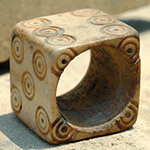
A comb and a hollowed-out die were both found in the harbor. (Pasquale Sorrentino)
Discussions are now underway with an international team including archaeologists and conservators from Germany and those who worked on the Roman ships from San Rossore, Pisa, about how to conserve the wood, which is expected to take at least five to six more years, and how to raise the several million euros needed to do so. In time the ships will be moved to special tanks for desalinization and eventually Giampaola hopes they will be exhibited in a museum built in the Piazza Municipio to house the finds from the excavation.
If Piazza Municipio is chaotic, there is no word to describe Piazza Nicola Amore four blocks away, where heavy traffic careens around the square, peeling off into streets that reach out from the center like spider legs. It took us, a native New Yorker and a native Neapolitan, no strangers to city traffic or crazy drivers, no fewer than 20 minutes to find a brief opening in the traffic to cross to the center of the piazza. Even then several cars came to a screeching halt and the air was filled with colorful Neapolitan curses. In the middle of this particular circle of hell, works archaeologist Beatrice Roncella. She is barely separated from the chaos by large wooden panels that protect her team and the remarkable finds that are yielding evidence of one of Neapolis' least known yet most important ancient events.
During the mid-nineteenth century, excavations in the area uncovered several ancient architectural and inscription fragments, marble sculptures, and large pieces of pavement, as well as some evidence of the early Greek street grid—tantalizing clues that this area was crucial for understanding the history of Neapolis' topography. However, until now, proper excavation of the area has never been done, due to persistent flooding that began as early as the second century A.D. and the later explosion of modern building atop the ancient neighborhood.
Roncella and her team were stunned when they started excavating undisturbed Roman levels and right away began finding dozens of very large architectural blocks and pieces of colored marble pavement. In a rare moment of archaeological good fortune, the first inscription Roncella found read: "We are the Roman Augustan games equal to the [games] in Olympia." Immediately she realized that the inscription referred to the little-known Isolympic Games, known from an inscription in Olympia, Greece, and that it came from a temple to Divus Augustus, the divine emperor Augustus.
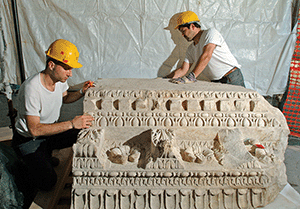
The cornice from the temple portico in Piazza Nicola Amore is cleaned and restored. (Pasquale Sorrentino)
The Isolympic Games were instituted by Augustus in A.D. 2 and it is not surprising that the emperor chose Neapolis, a city founded by Greeks, for this Hellenic-style contest of human and equestrian events. Eventually Roncella and her team discovered more than 400 pieces of Greek-inscribed marble panels that had once covered the walls of a large portico in front of the Augustus temple, whose podium, pavement, roof fragments, and column pieces have now been found.
The first-to-second-century temple's portico was at least 40 feet long and more than nine feet high; its panels hold by far the greatest number of Greek inscriptions anywhere in Italy. Once translated, the panels, a catalogue of the names and hometowns of the winners of the games, gave archaeologists two great surprises. "First, we did not know that so many of the athletes were from Asia Minor, which may tell us something about the makeup of the city in the first and second centuries A.D.," Roncella explains. The second major surprise was that "contrary to our beliefs, women were winning prizes on equal footing with men," she adds, referring especially to one Thalassia, a female competitor from Ephesus in Turkey. In addition to the athletic and equestrian events, the panels revealed that there were writing contests and prizes for the best comic and tragic authors, best actor, best composer, best lyre player, and so on. "It was kind of like the Oscars," adds Roncella. The dramatic and musical contests must have taken place in a theater, likely the one whose remains can now be seen on the Via dell'Anticaglia, and the equestrian events in the hippodrome in Piazza Garibaldi (a rival to Municipio and Nicola Amore for most frenetic piazza in Naples). That the inscriptions relating to the winners of the Games are found near Piazza Nicola Amore suggests to Roncella that the procession of winners must have ended at the temple.
To focus on the extraordinary discoveries of the Roman ships, Isolympic Games inscriptions, and the temple to Augustus is to ignore the great number of smaller, yet no less important, discoveries that have been (and are still being) made all over the city. At the site of the future Stazione Toledo, traces of plowed fields and a few ceramic sherds from a Neolithic settlement dating to the fourth millennium B.C. completely surprised archaeologists who have struggled to find any evidence from this period in the area. In the southwest of the city, known to have been a residential neighborhood in antiquity, excavators uncovered an elegant bath complex covered in beautiful frescoes dating to the second century A.D. In the area of the Isolympic complex, Roncella and her team identified a commercial zone filled with workshops for glass and metalwork, and for the merchants who supplied the Roman fleet from the mid-third century A.D. on, after the temple went out of use and the area lost its religious associations.

An excavator displays pieces of a terracotta mask and lamps found during the excavation of the port in Piazza Municipio. (Pasquale Sorrentino)
The excavations have also added much to the knowledge of the later city of Naples, including new evidence of the mid-sixth-century A.D. Byzantine walls, the first to have been located, and a Byzantine cemetery, both in the ruins of the Isolympic complex. Archaeologists have also found evidence of the beautification of the city undertaken by the Normans and Angevins, and located the thirteenth-century water supply system. They have also unearthed hundreds of pieces of green glazed Islamic wares at several sites, testament to the enduring importance of the city as a trading port and to its continued contact with the world's new powers throughout the Middle Ages. For the first time, too, scholars can see how the fortification of the Angevin castle, later taken over by the Aragonese rulers of the Kingdom of Naples in the fifteenth century, connected to the port in the Piazza Municipio. And with excavations continuing for years to come, there will surely be more discoveries.
For now, most of the more than 3.3 million (and growing) artifacts from the Metropolitana excavations are stored in three nondescript warehouses in Piscinola, next to the building housing the Roman ships. The well-guarded gray steel structures are already filled to overflowing with bright yellow and white plastic trays holding ceramics, pieces of marble column drums and capitals, inscriptions, decorative plaster, painted fresco fragments, stone ballista balls, anchors, and animal bones. Some of the larger architectural elements, such as the thirteenth-century fountain from the courtyard of the temple in Piazza Nicola Amore, where the subway tunnel is more than 60 feet lower than the level of the temple, cannot be accommodated on site, so they have been moved intact to the warehouses. Many of the larger remains have been left in situ for future metro passengers to see in the museum-like spaces of the stations, and some of the smaller artifacts will go back to the sites when work is completed. In the future, tens of thousands of Neapolitans who take the metro every day (will they give up those cars and Vespas?) will see their city's history in a way that was never before possible. The busy modern coastline next to the ancient port, the now-visible 750-year history of the castle that dominates the city center, the traces of the area's earliest inhabitants as many as 7,000 years ago, and the surprising evidence of a competition that would have brought the ancient city together in a way familiar to soccer-crazed Italians, all will become a part of the daily life of this fascinating city. Hopefully, Neapolitans will stop long enough to look.
Jarrett A. Lobell is executive editor at ARCHAEOLOGY. Marco Merola is ARCHAEOLOGY's Naples correspondent.

To read more about the classical world, click here to buy a copy of our special issue.
Advertisement

Advertisement







